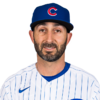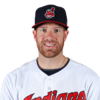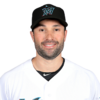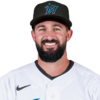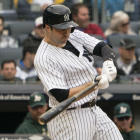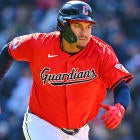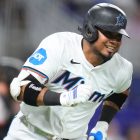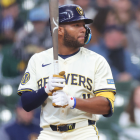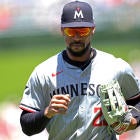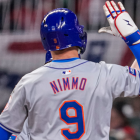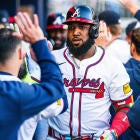It's again time for "Cyber Monday," that pseudo-holiday following Thanksgiving weekend when we're coerced into a capitalistic frenzy with deals and discounts online. Everyone wants a bargain, after all, and that includes baseball teams. We've decided to partake in the madness by highlighting 10 free agents who could yield greater value to their employer than their expected salaries suggest.
We're legally obligated to note we're omitting household names who may come cheaper than previously anticipated. We know Andrew Miller, Cody Allen and others of that ilk could be a bargain just as you know they could be a bargain. Why waste our lives noting the obvious? Instead, let's get funky with this convoluted exercise by thinking harder and digging deeper.
Here, then, are the 10 players we've identified -- and the reasons why they're on the list. Note the players are presented in alphabetical order.
Trevor Cahill has re-established himself the last two seasons as a legitimate rotation option to little fanfare with the San Diego Padres and Oakland Athletics. In 2018 he appeared 21 times, recording a career-best 2.44 strikeouts per walk. Cahill's formula for success includes his low-90s sinker and a trio of bat-missing secondaries: a diving changeup, a spike curve and a cutter-slider thingamajig. He's landed on the disabled list five times in the past two years, four of those stemming from shoulder and elbow woes. There's no reason to pencil in Cahill for 180 innings (heck, he hasn't topped 150 in the majors since 2012), but his arsenal will give him a chance to contribute until his arm gives out.
There are numerous left-handed platoon-outfielder types available this winter -- Curtis Granderson, Carlos Gonzalez, Matt Joyce to name a few. Lonnie Chisenhall, who recently turned 30, is younger than them all. Alas, his youth has been wasted. Chisenhall hasn't appeared in more than 100 games since 2016 and was limited to 29 appearances last season by a strained calf. When he has played, he's reached base at least 33 percent of the time against righties in four of the past five seasons. Chisenhall gets underneath the ball too often to maximize his offensive production, and he's not the outstanding defender that public metrics suggested in past years (though he is skilled at coming in on balls). Still, if his body holds up he could make for a nifty one-year fix for someone.
Hey, we're just as surprised as you are that Daniel Descalso is on a list like this. But he's coming off a career season and has posted a 94 OPS+ over the last three years -- that's better than Josh Harrison (91) across the same time frame. Descalso has a keen eye at the plate and can theoretically play all over the diamond, gifting him a super-utility appeal. Sure, sure, you say, but how legitimate are those offensive gains? It's tough to tell. He did improve both his launch angle and exit velocity in 2018, however, and that would seem to bode well for some retention. A team who believes the same could make him the (cheap) heavily used option in a platoon at second base.
Marco Estrada is a command artist with an upper-80s fastball. As such, it's tempting to view his abysmal 2018 (his 74 ERA+ was a full-season worst) as evidence he's exhausted his utility as a starting pitcher. Maybe so, but there is some reason to think he has a rodeo or two left in him. Estrada's strikeout-to-walk rate was again over 2.00, and he continued to generate swing-and-misses with his north-south fastball-changeup approach. Estrada's biggest issue was giving up a career-worst 1.8 home runs per nine. Because yielding dingers is part of his core identity, the matter at hand heading forward is whether he can get that figure back in the 1.2-1.5 range it populated from 2015-17. If so -- and remember, homer rates are known to fluctuate year-to-year -- he could be a passable back-end option. If not, maybe he takes up the rodeo for real. It's an honest living.
For as bad as Brandon Guyer's season looked -- and it looked bad, given his 80 OPS+ -- he still did what he's around to do: hit left-handed pitchers. Guyer posted an OPS over .800 against southpaws for the third time in his last four tries. Unfortunately, he saw nearly as many plate appearances against righties -- Cleveland's lacking outfield depth left them with no choice other than to overexpose him -- and that did a number on his overall line. Guyer's atrociousness against same-handed pitching gives him a low ceiling but he should make for a fine reserve on a platoon-obsessive team -- and he should come cheaply.
Jordan Lyles has been well below replacement for his career. Why in God's name is he on here? Because he's always been a good athlete and some mechanical and tactical tweaks he made last season have better positioned him for success. Lyles recorded new career-highs in velocity, strike and strikeout percentages. He leaned into using his spike curve more often, seemingly a smart decision given it's the closest thing he has to an out pitch. Add it all together and we're optimistic that Lyles' best work lies ahead.
Overshadowed at his peak by Cody Allen and Andrew Miller, it only made sense that Allen and Miller's collapses would obscure Zach McAllister's downfall, too. He was released after 40-something bad innings that saw his K rate plummet and his hit and home-run rates jump. Oddly, McAllister allowed a lower exit velocity last season than he had in either 2016 or 2017, and also threw a higher percentage of strikes than he had ever before. Those and his whiff rate suggest he's a fine bounce-back candidate. Expect him to slot into a middle-relief role.
Let's keep this simple: Rene Rivera is a backup catcher. He should not enter the spring as anyone's starter by design. But he's an above-average defender who has outhit Martin Maldonado -- a popular name on these kinds of lists thanks to the exposure he received with the Houston Astros -- over the last three seasons, albeit in fewer plate appearances. Rivera has bounced around and is sure to come cheap, perhaps even on a minor-league contract.
Is Neil Walker too popular for this group? Maybe. Last year marked the first time in his career he posted an OPS+ below 100 -- impressive, considering it was his ninth full season. The funny thing is Walker looked like a great value when he signed with the New York Yankees, and has the potential to live up to that label in 2019. A number of his tracking metrics -- exit velocity, barrel percentage -- were better last season than in 2017. Go figure. A return to form would make the switch-hitting Walker an asset against right-handed pitchers. Bet on him getting the chance.
Nick Vincent has consistently posted strong strikeout-to-walk ratios -- at least 3.50 in each of the past three years -- but hasn't always had the ERA to show for it. In two of the past three seasons, his ERA+ has been below 110. As a result, the Seattle Mariners deemed him expendable. Some other team will bring Vincent in a one-year deal as a middle reliever. He isn't overpowering -- he's almost 100 percent mid-to-upper-80s cutters and four-seamers -- but he throws strikes and sometimes that's enough to get the job done. Just, evidently, not always enough.










